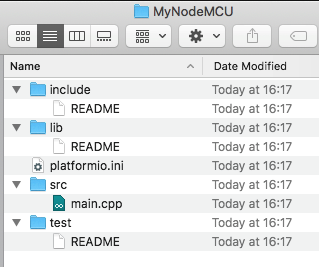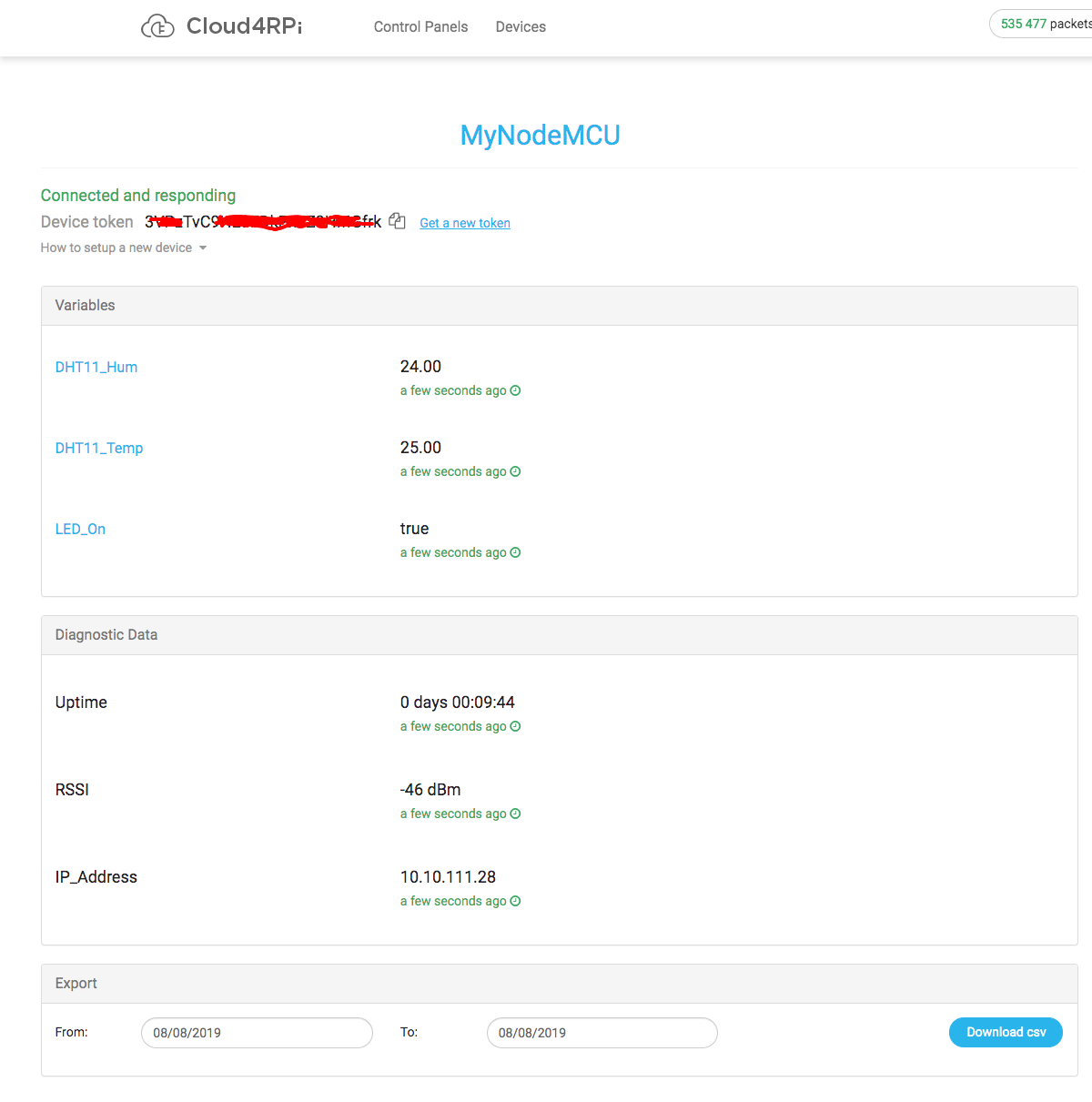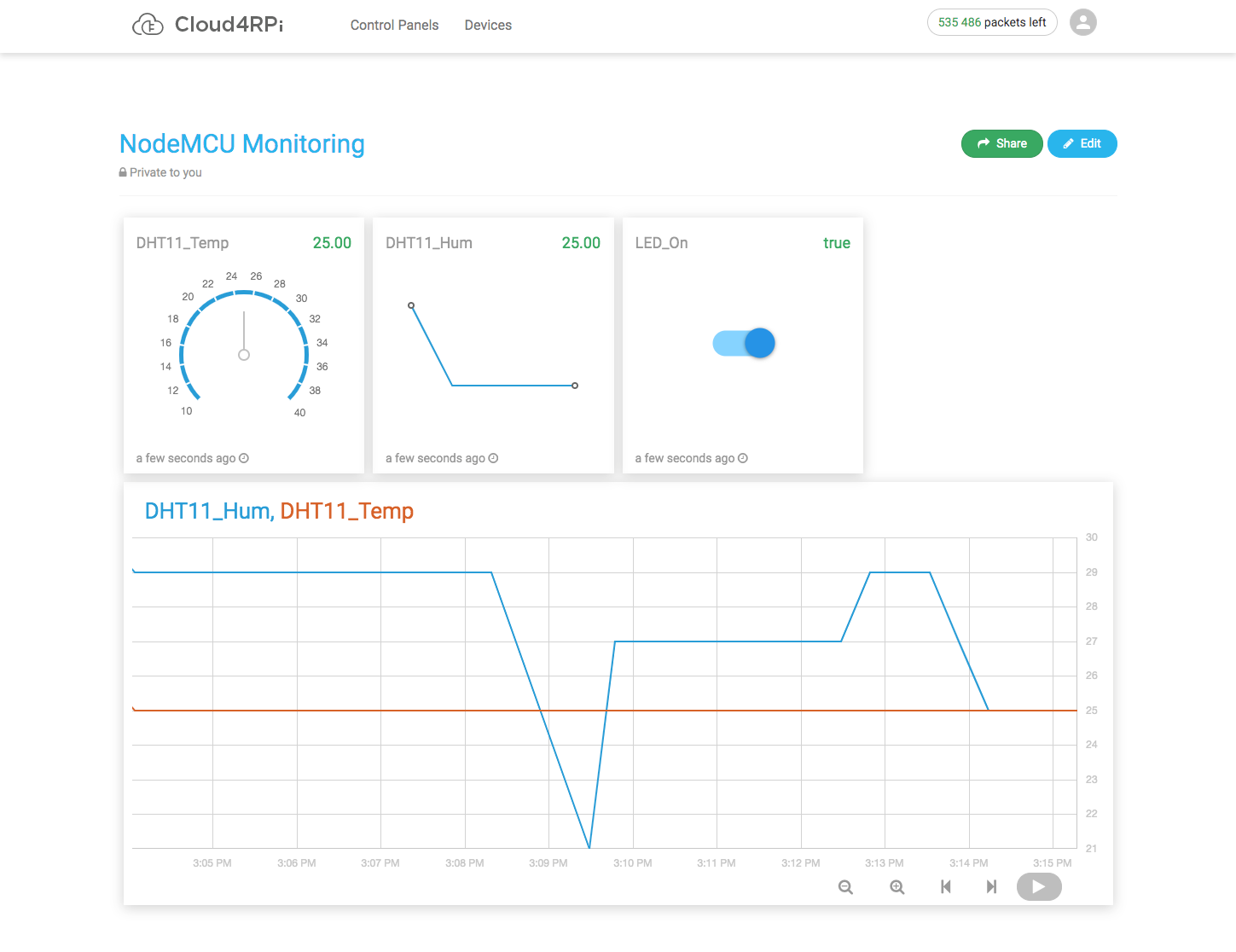-
1Step 1: Create and configure project
I already described how to create a PlatformIO project and install libraries in the first part. My project is called “MyNodeMCU”. The structure is shown below:
![]()
This project is a slightly modified Cloud4RPi example.
I decided to store the device token and Wi-Fi credentials in the configuration file instead of code.
The platform.ini file looks as follows:
[platformio] default_envs = nodemcuv2 [env:nodemcuv2] platform = espressif8266 framework = arduino board = nodemcuv2 -
2Step 2: Install libraries
Libraries installation is quite simple. You can do it from the IDE’s graphical interface, or by adding required library names to the
lib_depssection of the platform.ini file:; ... lib_deps = cloud4rpi-esp-arduino Adafruit Unified Sensor DHT sensor library build_flags = -D MQTT_MAX_PACKET_SIZE=1024 -D MQTT_MAX_TRANSFER_SIZE=128 -D CLOUD4RPI_DEBUG=0 -D SSID_NAME=\"__YOUR_WIFI__\" -D SSID_PASSWORD=\"__YOUR_WIFI_PASS__\" -D CLOUD4RPI_TOKEN=\"__YOUR_DEVICE_TOKEN__\"Added libraries will be automatically installed into a project’s subfolder.
![]()
The
main.cppheader looks as follows:#include <arduino.h> #include <esp8266wifi.h> #include <cloud4rpi.h> #include "DHT.h" -
3Step 3: Connect a DHT11 sensor
Adafruit provides a
DHTtester.inoexample of a sensor connection.This code initializes a sensor and defines a structure to store the measurement result (in case it was successful):
#define DHTPIN 2 // Digital pin connected to the DHT sensor #define DHTTYPE DHT11 // DHT 11 // ... DHT dht(DHTPIN, DHTTYPE); dht.begin(); // ... struct DHT_Result { float h; float t; }; DHT_Result dhtResult; -
4Step 4: Sending data to the cloud
Once we have that data, the next step is to send it to the Cloud4RPi service.
The Cloud4RPi for Arduino page describes the library API, which is a set of methods used to:
-create, read and update variables, -send variable values into the cloud using the MQTT protocol.
The library supports three variable types: Bool, Numeric, and String.
The library workflow starts with creating an API instance using the Device Token from the cloud4rpi.io website (refer to the article’s part 1 for details).
#if defined(CLOUD4RPI_TOKEN) Cloud4RPi c4r(CLOUD4RPI_TOKEN); #else Cloud4RPi c4r("!!!_NO_DEVICE_TOKEN_!!!"); #endifThen, declare variables for DHT11 readings:
c4r.declareNumericVariable("DHT11_Temp"); c4r.declareNumericVariable("DHT11_Hum");Then, get data from the sensor, save them into variables and publish the data to Cloud4RPi:
c4r.setVariable("DHT11_Temp", dhtResult.t); c4r.setVariable("DHT11_Hum", dhtResult.h); c4r.publishData();Temperature and humidity does not change quickly, so sending more than one value per 5 minutes is not required.
-
5Step 5: Diagnostics
Cloud4RPi supports diagnostic data along with variable values. I used uptime, Wi-Fi signal strength, and IP address as diagnostic data:
c4r.declareDiagVariable("IP_Address"); c4r.declareDiagVariable("RSSI"); // WiFi signal strength c4r.declareDiagVariable("Uptime");Note: The millis function I use to obtain uptime resets to zero every ~50 days. Which is more than enough for my project.
The following code sets diagnostic variable values:
c4r.setDiagVariable("RSSI", (String)WiFi.RSSI() + " dBm"); c4r.setDiagVariable("IP_Address", WiFi.localIP().toString()); c4r.setDiagVariable("Uptime", uptimeHumanReadable(currentMillis)); c4r.publishDiag();The
uptimeHumanReadablefunction converts milliseconds to a convenient form:String uptimeHumanReadable(unsigned long milliseconds) { static char uptimeStr[32]; unsigned long secs = milliseconds / 1000; unsigned long mins = secs / 60; unsigned int hours = mins / 60; unsigned int days = hours / 24; secs -= mins * 60; mins -= hours * 60; hours -= days * 24; sprintf(uptimeStr,"%d days %2.2d:%2.2d:%2.2d", (byte)days, (byte)hours, (byte)mins, (byte)secs); return String(uptimeStr); }The function outputs a string like this
5 days 10:23:14instead of a strange big number. -
6Step 6: Start and debug the project
After compiling the created code and flashing it into NodeMCU, the device connects to a cloud service and starts sending data.
You can increase logging verbosity by setting the
CLOUD4RPI_DEBUGpreprocessor variable to1(add-D CLOUD4RPI_DEBUG=1tobuild_flagssection in platform.ini file).Next, open the cloud4rpi.io site and notice the new device online. Open it to see all variable values received from the device: sensor and diagnostics.
![]()
-
7Step 7: Dashboard configuration
At this step, the data connection to the cloud is operational. Now, let’s configure the visual representation of the data.
I used the Dashboard configuration UI to create the following dashboard:
![]()
The dashboard is shareable, so I instantly share it with my friend.
-
8Conclusion
The full project’s code is available in the gist.
That’s all for now!
Questions and suggestions are welcome in the comments.
Connecting DHT11 to the cloud using ESP8266 board
How to connect a DHT11 sensor to the cloud with an ESP8266-based board using the Arduino framework.
 Cloud4RPi
Cloud4RPi



Discussions
Become a Hackaday.io Member
Create an account to leave a comment. Already have an account? Log In.